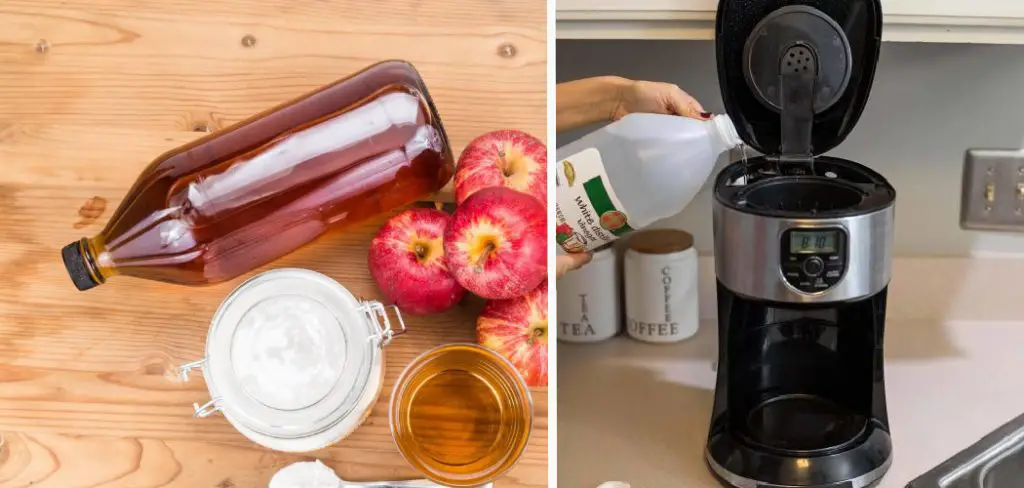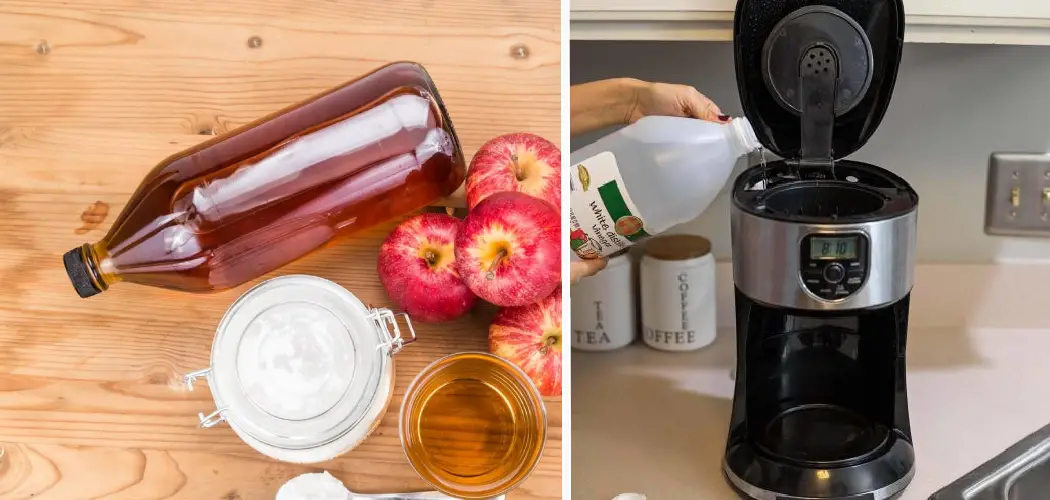Are you looking for an easy and inexpensive way to clean your coffee maker? If so, then apple cider vinegar could be the perfect answer! Not only it is natural and non-toxic, but it’s also highly effective at removing limescale buildup from the interior of your machine.
Plus, using this simple cleaning method can help improve the taste of your next cup of java by getting rid of any stale odors. In this blog post, we’ll show you how to use apple cider vinegar as a powerful kitchen hack that will make your coffee maker look brand new in no time! So, keep on reading to learn more about how to clean coffee maker with apple cider vinegar.

Can You Clean the Coffee Maker with Apple Cider Vinegar?
If you’re a coffee aficionado, caring for your coffee maker is just as important as choosing the right beans. We trust these machines to brew a perfect cup of coffee each time. However, over time these machines can collect buildup and mold, which can ruin the taste of our beloved beverage.
That’s where apple cider vinegar comes into play. This powerful cleaning agent removes any buildup and can disinfect your coffee maker. So, the short answer to the question is yes, you can clean your coffee maker with apple cider vinegar. Keep reading to learn how to use it effectively for a fresh and delicious cup of coffee every time.
Why Should You Clean a Coffee Maker with Apple Cider Vinegar?
If you are an avid coffee drinker, you know the importance of a good cup of joe in the morning. But did you know cleaning your coffee maker is as important as brewing a great cup? Using apple cider vinegar to clean your coffee maker is a simple and effective way to remove mineral buildup, grease, and other impurities that can affect the taste of your coffee.
This natural solution is non-toxic, inexpensive, and easy to use. Regularly cleaning your coffee maker with apple cider vinegar can extend your machine’s life and ensure a delicious cup of coffee every time. So, if you care about the quality of your coffee, make sure you give your coffee maker the attention it deserves and try using apple cider vinegar for a sparkling clean machine.
Materials Needed for Cleaning Your Coffee Maker with Apple Cider Vinegar
Before beginning the cleaning process, you’ll need a few supplies on hand. Here’s what you’ll need:
- Coffee maker
- Water
- Apple cider vinegar
- Dish soap
- Soft cloth or sponge
How to Clean Coffee Maker with Apple Cider Vinegar: A Simple Guide
Step 1: Mix the Cleaning Solution

The first step to cleaning your coffee maker with apple cider vinegar is to mix a solution of equal parts water and vinegar. Use enough solution to fill the water reservoir and start a brewing cycle. Once the process begins, stop it halfway through and let the solution sit in the reservoir for about 30 minutes. This allows the vinegar to break down the mineral buildup and coffee residue that may be present.
Step 2: Run a Cleaning Cycle
After the solution has sat in the reservoir for 30 minutes, restart the brewing cycle and let it run its full course. The vinegar solution will pass through the coffee maker, cleaning out any buildup in the machine. Make sure to let the solution cool before discarding it.
Step 3: Rinse the Machine
Once the cleaning cycle is complete, empty the carafe and discard the used filter. Rinse the water reservoir and carafe thoroughly with clean water to remove any remaining vinegar solution. You can also run a cycle with clean water to flush out any remaining vinegar.

Step 4: Clean the Exterior
In addition to cleaning the internal parts of your coffee maker, you should also clean the external surfaces. Use a cloth or sponge to wipe the machine’s exterior with mild soap and water. Rinse with clean water and dry with a towel.
Step 5: Repeat the Process Regularly
To maintain your coffee maker’s cleanliness and quality, it’s important to repeat this cleaning process every month or so. Regular maintenance will keep your coffee maker functioning at its best and prevent any buildup from affecting the taste of your coffee.
Step 6: Descale the Machine
If your coffee maker begins to produce bitter-tasting coffee or you notice a buildup of white scale on the internal parts of your machine, it’s time to descale it. To do this, mix equal water and vinegar and fill the reservoir with the solution. Start a brewing cycle and let it run its full course. Discard the solution after it has cooled and repeat the process a few times until all scale is removed.
Step 7: Replace Filters Regularly
Finally, make sure to replace your coffee maker’s filter regularly. A dirty filter can affect the taste of your coffee and reduce its overall quality. To ensure you get the best cup of coffee possible, replace the filter every few months.
By following these steps and regularly cleaning your coffee maker with apple cider vinegar, you can keep it in great shape and enjoy delicious cups of coffee for years to come!
5 Considerations Things When You Need to Clean Coffee Maker with Apple Cider Vinegar
1. The Type of Coffee Maker
When cleaning a coffee maker with apple cider vinegar, it is important to consider the type of coffee maker that you have. Some coffee makers are made with materials incompatible with vinegar, such as aluminum. If you have an aluminum coffee maker, it is best to avoid using vinegar as it can cause the aluminum to corrode.
2. The Size of The Coffee Maker
Another consideration is the size of the coffee maker. If you have a small coffee maker, you will need to use less vinegar than a large one. This is because too much vinegar can damage small coffee makers.
3. The Frequency of Use
If you only use your coffee maker occasionally, you may not need to clean it as often as someone who uses their coffee maker daily. However, if you do use your coffee maker frequently, it is important to clean it regularly to prevent build-up from occurring.

4. The Severity of The Build-Up
The severity of the build-up will also dictate how often you need to clean your coffee maker with apple cider vinegar. If there is only a small build-up, you may only need to clean it once or twice a year. However, you may need to clean it more frequently if there is significant build-up.
5. Your Personal Preference
Ultimately, how often you clean your coffee maker with apple cider vinegar is a personal preference. Some people prefer to clean their coffee maker every month, while others only do so when they notice a residue build-up.
Benefits of a Clean Coffee Maker with Apple Cider Vinegar
Are you a coffee lover who can’t go a day without brewing a fresh cup? Have you noticed that your coffee doesn’t taste as good as it used to, and your coffee maker looks a little grimy? It’s time to give your coffee maker a deep clean with apple cider vinegar.
Not only will your coffee taste better, but a clean coffee maker eliminates the buildup of harmful bacteria and helps extend the life of your machine. Plus, apple cider vinegar is a natural and non-toxic solution that won’t leave harmful chemicals in your machine.
So, grab a bottle of apple cider vinegar and show your coffee maker some love with a good cleaning. Your taste buds (and coffee makers) will thank you!
Common Mistakes People Make When Trying to Clean Coffee Maker with Apple Cider Vinegar
1. Not Using Enough Vinegar
One of the most common mistakes people make when cleaning their coffee maker with apple cider vinegar is not using enough. You need to use a 1:1 ratio of water to vinegar for the cleaning solution to be effective. Using too little vinegar won’t be strong enough to remove all the built-up coffee residue and oils from your coffee maker.
2. Not Letting the Solution Sit Long Enough
Another mistake people make is not letting the cleaning solution sit in the coffee maker long enough. You must let the solution sit for at least 30 minutes to work properly. If you don’t let it sit long enough, the vinegar won’t have enough time to break down the built-up coffee residue and oils.
3. Not Using Hot Water
Another common mistake people make when cleaning their coffee maker with apple cider vinegar is not using hot water. You need to use hot water for the cleaning solution to be effective. The hot water will help break down the built-up coffee residue and oils so they can be easily removed from your coffee maker.

4. Not Rinsing Well
The final mistake people often make when cleaning their coffee maker with apple cider vinegar is not rinsing it well afterward. It’s important to rinse your coffee maker thoroughly after using the cleaning solution to remove all traces of vinegar. Your coffee may taste like vinegar if you don’t rinse it well.
5. Not Descale The Machine
If your coffee maker has been in use for a while, you may also need to descale it with vinegar. If there is white scale buildup on the internal parts of your machine, it’s time to descale it by running equal parts water and vinegar through the brewing cycle several times until all scale is removed.
6. Not Replacing Filters Regularly
Don’t forget to replace your coffee maker’s filter regularly. A dirty filter can affect the taste of your coffee and reduce its overall quality, so it’s best to replace it every few months.
7. Using Too Much Vinegar
It’s also important not to overdo it when cleaning your coffee maker with apple cider vinegar. Too much vinegar can be damaging to specific materials and also affect the taste of your coffee. Stick to a 1:1 ratio of water to vinegar for optimal results.
8. Not Cleaning Your Coffee Maker Enough
Finally, make sure you’re cleaning your coffee maker with apple cider vinegar regularly. Depending on how often you use it, this should be done about once a month or more if necessary. By keeping your coffee maker clean, you can enjoy a great cup of joe for years to come!
These are just a few tips to keep in mind when cleaning your coffee maker with apple cider vinegar. With proper maintenance and regular cleaning, you can extend the life of your machine and save money by not having to buy a new one as often!
What to do if your coffee maker has been damaged by using ACV
If your coffee maker has been damaged by using Apple Cider Vinegar (ACV), there are a few steps you can take to try and rectify the situation.
- Cease Using ACV: If you believe that ACV has damaged your coffee maker, stop using it immediately. ACV can cause corrosion in certain types of coffee makers, and further usage might lead to more damage.
- Clean with Warm Water: Rinse the coffee maker multiple times with warm water. This helps to remove any remaining vinegar that could continue to cause damage.
- Inspect for Damage: Check all removable components for signs of damage, such as discoloration, corrosion, or any other irregularities. If damaged parts are replaceable, order new ones.
- Seek Professional Help: If the damage is significant or if you’re unsure about the severity of the injury, consider seeking help from a professional appliance repair service. They can better diagnose the problem and offer appropriate solutions.
- Consider Replacement: If the damage is extensive and the repair cost equals or exceeds the cost of a new coffee maker, it might be time to consider a replacement.
Remember, it’s essential to know the materials used in your coffee maker before cleaning with any acidic substance like ACV. Always follow manufacturer guidelines for cleaning and maintenance to avoid such problems in the future.
Safety Precautions During Cleaning
Taking safety precautions while handling cleaning solutions and maintaining your coffee maker can prevent accidents and damage to your machine. It’s important to remember, first and foremost, that the cleaning solutions we use, while effective, can be potentially harmful if mishandled. Exposure to concentrated vinegar, for example, can cause skin irritation or eye discomfort.
To prepare for cleaning, always ensure that the coffee maker is unplugged before you start. This not only protects the machine’s electrical components from potential water damage, but it also safeguards you from accidental electrical shocks during the cleaning process. It’s always better to be safe than sorry.
We also recommend wearing protective gloves when handling the cleaning solution. Gloves will protect your hands from the acidity of the vinegar, reducing the risk of skin irritation. If the solution accidentally splashes, it will be your gloves that bear the brunt and not your skin.
Remember, safety should always come first when maintaining and cleaning your appliances. Following these precautions will allow you to clean your coffee maker while minimizing any potential risks effectively.
Alternative Cleaning Methods for Coffee Makers
If you don’t have apple cider vinegar on hand or you are worried about potential damage, there are other methods for cleaning your coffee maker. This section can detail how to use baking soda, lemon juice, or commercial cleaning products for effective cleaning.
Understanding the Importance of Regular Cleaning
Regular cleaning of your coffee maker is essential to ensure that it continues to function efficiently and produce delicious coffee. Neglecting regular cleaning can result in a buildup of residue, oils, and bacteria, which can affect the taste and quality of your coffee and even lead to damage over time.
Incorporating simple cleaning practices into your routine, you can ensure your coffee maker stays in top condition and enjoy a perfect cup of coffee every time. Happy brewing!
Maintenance Tips for Your Coffee Maker
To ensure the longevity of your coffee maker and consistently good-tasting coffee, it’s crucial to maintain your machine properly. Incorporating some simple habits can make a big difference.
A. Regularity of Cleaning
Consistently cleaning your coffee maker is the key to its longevity and performance. Depending on how often you use your coffee maker, cleaning should be done at least once a month. However, if your coffee maker is used daily, consider cleaning it every other week to prevent the buildup of coffee residues and oils that can affect the taste of your coffee.
B. Additional Preventive Measures
Apart from regular cleaning, there are other preventive measures that you can take to optimize the functionality of your coffee maker:
1. Using Filtered Water
Tap water may contain minerals and impurities that can accumulate inside your coffee maker over time, causing scale buildup that can affect both the machine’s performance and the taste of your coffee. Using filtered water not only enhances the flavor of your coffee but also lengthens the life of your machine.
2. Using a Water Softener If Applicable
If you live in an area with hard water, consider using a water softener. Hard water contains high amounts of minerals such as calcium and magnesium, which can lead to limescale buildup in your coffee maker. This buildup can affect the machine’s performance and even shorten its lifespan. Using a water softener can prevent this issue, ensuring your coffee maker runs smoothly for years to come.
DIY Coffee Maker Cleaning Recipes
Maintaining a clean coffee maker doesn’t always require special cleaning products. In fact, you can achieve excellent results with items commonly found in most kitchens. Here are some simple DIY cleaning recipes for your coffee maker:
Baking Soda Cleaning Solution
Baking soda is a natural cleaner and deodorizer, making it a perfect ingredient for cleaning your coffee maker. To use baking soda:
- Add a quarter cup of baking soda to the coffee pot.
- Fill the pot with warm water and stir until the baking soda is fully dissolved.
- Pour the solution into the coffee maker’s water reservoir and run a brewing cycle.
- Once the brewing cycle is complete, run a few cycles of clean water to rinse.
Lemon Juice Cleaning Solution
Lemon juice, like vinegar, is acidic and has natural cleaning properties. To clean with lemon juice:
- Fill the water reservoir with equal parts water and lemon juice.
- Run a brewing cycle.
- Follow up with a few cycles of clean water to ensure there’s no lemon taste in your next cup of coffee.
Denture Tablets Cleaning Solution
Denture tablets can be a surprisingly effective cleaning agent for your coffee maker. To use denture tablets:
- Fill the coffee pot with warm water and drop in two denture tablets.
- Allow the tablets to fizz and dissolve completely.
- Pour the solution into the water reservoir and run a brewing cycle.
- Rinse thoroughly with clean water.
Remember, regular cleaning using these DIY methods can help extend the life of your coffee maker and improve the taste of your coffee. Always rinse your coffee maker thoroughly after cleaning to ensure no residue of the cleaning agent remains.
Conclusion
Cleaning your coffee maker with apple cider vinegar is a simple and effective process that only takes a few minutes. With regular maintenance, you can ensure that your coffee maker produces delicious coffee every time. The next time you notice your coffee tasting a little off, try this cleaning method and see the difference it makes. Thanks for reading our post about how to clean a coffee maker with apple cider vinegar, and happy brewing!
You Can Check it Out to Boil Water in Instant Pot Without Lid

